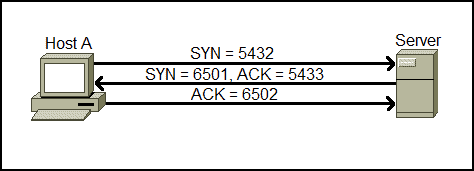Do you want BuboFlash to help you learning these things? Or do you want to add or correct something? Click here to log in or create user.
Answer
As the name implies, the three way handshake process consists of three steps:
-
- Host A initiates the connection by sending the TCP SYN (random number 5432 marks sequence beginning ) packet to the destination host.
- The Server receives the packet and responds with its own sequence number. The response also includes the ACK (Host A’s sequence number+ 1 = 5433).
- Host A acknowledges the response of the Server by sending the ACK, which is the Server’s sequence number + 1.
Answer
As the name implies, the three way handshake process consists of three steps:
-
- Host A initiates the connection by sending the TCP SYN (random number 5432 marks sequence beginning ) packet to the destination host.
- The Server receives the packet and responds with its own sequence number. The response also includes the ACK (Host A’s sequence number+ 1 = 5433).
- Host A acknowledges the response of the Server by sending the ACK, which is the Server’s sequence number + 1.
If you want to change selection, open document below and click on "Move attachment"
TCP three-way handshake
municate. TCP uses a process called three-way handshake to negotiate the sequence and acknowledgment fields and start the session. Here is a graphical representation of the process: [imagelink] <span>As the name implies, the three way handshake process consists of three steps: Host A initiates the connection by sending the TCP SYN packet to the destination host. The packet contains the random sequence number (e.g. 5432) which marks the beginning of the sequence numbers for data that the Host A will transmit. The Server receives the packet and responds with its own sequence number. The response also includes the acknowledgment number, which is Host A’s sequence number incremented by 1 (in our case, that would be 5433). Host A acknowledges the response of the Server by sending the acknowledgment number, which is the Server’s sequence number incremented by 1. Here is another picture with the numbers included: [imagelink] After the data transmission process is finished, TCP will terminate the connection between two endpoints. This four-step p
TCP three-way handshake
municate. TCP uses a process called three-way handshake to negotiate the sequence and acknowledgment fields and start the session. Here is a graphical representation of the process: [imagelink] <span>As the name implies, the three way handshake process consists of three steps: Host A initiates the connection by sending the TCP SYN packet to the destination host. The packet contains the random sequence number (e.g. 5432) which marks the beginning of the sequence numbers for data that the Host A will transmit. The Server receives the packet and responds with its own sequence number. The response also includes the acknowledgment number, which is Host A’s sequence number incremented by 1 (in our case, that would be 5433). Host A acknowledges the response of the Server by sending the acknowledgment number, which is the Server’s sequence number incremented by 1. Here is another picture with the numbers included: [imagelink] After the data transmission process is finished, TCP will terminate the connection between two endpoints. This four-step p
Summary
| status | not learned | measured difficulty | 37% [default] | last interval [days] | |||
|---|---|---|---|---|---|---|---|
| repetition number in this series | 0 | memorised on | scheduled repetition | ||||
| scheduled repetition interval | last repetition or drill |
Details
No repetitionsDiscussion
Do you want to join discussion? Click here to log in or create user.
